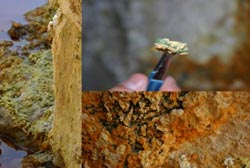The saline hiding places for bacteria in Río Tinto could be like those on Mars

The natrojarosite precipitates of Río Tinto hide microorganisms (green) within their salt microniches.<br><br>Credit: F. Gómez / CAB<br>
The high doses of radiation, lack of moisture and extreme temperature and pressure on the surface of Mars make the development of life difficult. Within this hostile environment, scientists are searching for “friendlier” niches that could encourage life. One of the candidates is the salt deposits.
A team from the Centre of Astrobiology (CAB, INTA-CSIC) has analysed this kind of environment on Earth: the salt deposits associated to a mineral with sulphur and iron named natrojarosite. It can be found in the Río Tinto basin in Huelva and is very similar to one detected on Mars: jarosite. Its presence reveals the past or present existence of water.
“The salt deposits are good 'hosts' for biological remains and even life itself in extreme circumstances,” as outlined to SINC by Felipe Gómez, coauthor of the study published in the 'Planetary and Space Science'.
“The reason is that conditions in this environment remain less adverse than those of their surroundings given that they provide protection from radiation for example, and they keep moisture levels higher than outside,” explains the researcher.
With the help of microscopic techniques and molecular ecology, the team has discovered a film of bacteria and algae living in salt 'microniches' invisible to the naked eye. Up to five different morphologies have been found of microorganisms belonging to the Dunaliella and Cyanidium genera.
The deposits analysed have been formed by layers each with a width of just a few millimetres. They make up a “completely different” ecosystem to the strange environment of Río Tinto.
“The precipitated minerals could only have been formed in such an acidic environment like this one and it is still even home to microbial communities in development. In order words, here they find their ideal environment,” says Gómez.
According to the study, “the discovery of these protected microniches in one of Mars' analogue on Earth, like Río Tinto, is an important step in evaluating the habitability potential of the red planet.”
NASA's Mars Global Surveyor probe has already detected alluvial fan-shaped salt formations on the Martian surface and scientists believe that that they could exist below the frozen ocean of one of Jupiter's satellites, Europa.
“From the astrological point of view, salt deposits are of great importance and should be considered when searching for life on space exploration missions, like the current Curiosity rover mission on Mars,” concludes Gómez. In fact, salt deposits of astrobiological interest have been found not far from where the NASA rover is.
On Earth the CAB team has also studied extreme salt environments in Chott el Djerid Lake (Tunisia) and under the Atacama Desert (Chile).
References:
F. Gómez, J.A. Rodríguez-Manfredi, N. Rodríguez, M. Fernández-Sampedro, F.J. Caballero-Castrejón, R. Amils. “Habitability: Where to look for life? Halophilic habitats: Earth analogs to study Mars habitability”. Planetary and Space Science 68 (1): 48, 2012.
Media Contact
More Information:
http://www.agenciasinc.esAll latest news from the category: Physics and Astronomy
This area deals with the fundamental laws and building blocks of nature and how they interact, the properties and the behavior of matter, and research into space and time and their structures.
innovations-report provides in-depth reports and articles on subjects such as astrophysics, laser technologies, nuclear, quantum, particle and solid-state physics, nanotechnologies, planetary research and findings (Mars, Venus) and developments related to the Hubble Telescope.
Newest articles

A universal framework for spatial biology
SpatialData is a freely accessible tool to unify and integrate data from different omics technologies accounting for spatial information, which can provide holistic insights into health and disease. Biological processes…

How complex biological processes arise
A $20 million grant from the U.S. National Science Foundation (NSF) will support the establishment and operation of the National Synthesis Center for Emergence in the Molecular and Cellular Sciences (NCEMS) at…

Airborne single-photon lidar system achieves high-resolution 3D imaging
Compact, low-power system opens doors for photon-efficient drone and satellite-based environmental monitoring and mapping. Researchers have developed a compact and lightweight single-photon airborne lidar system that can acquire high-resolution 3D…





















